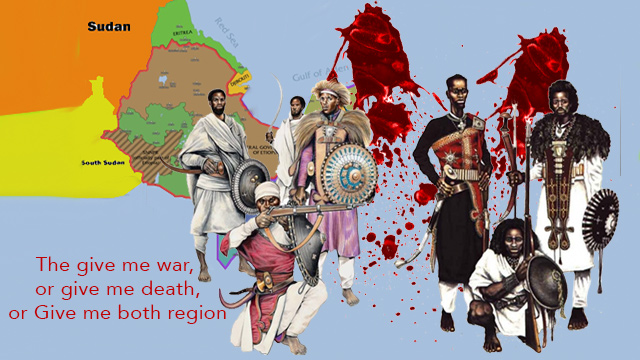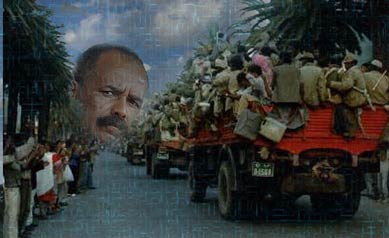Tigray Forces Enter Mekelle City

For a critical media consumer, various media outlets are meant to serve as a way to arrive at the truth as rapidly as possible. As well, to learn more about a particular subject matter of interest. Today, I woke up to write an article on the subject of genocide in Gambella, Ethiopia under the watchful eyes of the late PM Meles Zenawi, back in 2003. The fast developments of Tigray military forces roaring into Mekelle, and Ethiopian military forces vacating Tigray landscape, was a monumental game changer. No matter from what angle that one chooses to look at it, it is a major event that one must reckon with, idea-wise.
Although, matters are fluid now in that one never knows what direction the course of events will lead. One thing is for sure: I was completely wrong in my assessment of declaring that TPLF was dead. The dead part can easily be misconstrued with the wishing harm to the people of Tigray. It was not. There needs to be a clear distinction here that the reference is with the archaic idea that TPLF represented and still the people of Tigray must contend with moving forward. My reading of the events led me to make erroneous conclusion. Fairness demands it. Decency compels it. I admit that my assessment and my evaluations were wrong. Without any equivocation, I say kudos to the people of Tigray. This is a major milestone toward peace, one hopes, not toward vengeance, retribution, so the vicious cycle doesn’t continue unabated. Hopefully, cool heads will collect their heels and come up with what will help the people of Tigray to recover from the verge of starvation.
It’s prudent to remember that Western countries tend to place pressure behind the scenes. It was done in London and in Atlanta, Georgia back in 1991 when EPLF/TPLF and the Derg had to be pressured to cut a deal to minimize bloodshed. There could be a deal behind the scenes that we are not privy to. At this point we know one thing for sure: Tigrayans are in control of their territories. There may remain some disputed areas to the North of Tigray, South of Tigray, and West of Tigray. These will be details to be dealt with when the dust of war settles. Prime Minister Abi Ahmed appears to have been given a face-saving measure, the same could be the case for the Tigrayan forces as well.
The raid and counter-raid have been the established history of the region for as long as the Abyssinian land existed. Today is no different. The Eritrean Raasi so-and-so defeated the Ethiopian Raais so-and-so, or vice versa, can be repeated a100 times over, by merely changing the applicable names, we will arrive to the current war, Raasi Abiy Ahmed, the Raasi of Tigray… Raasi Isaias and Raasi …so on and so forth. Can there be a way out from this habituated, knee jerk reaction of raid and counterraid? Of course, there can be if these so-called leaders leave their egos in their respective pockets and speak in terms of the people they should genuinely represent. Moving forward, what path would the people of Tigray choose? So far, from the last seven months or even prior to the current war that’s winding down, there were and are at least four blocks of stakeholder within Tigray proper:
(1) The independence blocks
(2) The Remain with Ethiopia blocks
(3) The anarchist blocks who will go on the vendetta binge
(4) The Tigray-Tigrinya block
Depending on which block the people of Tigray choose, they will face formidable challenges. If the first one, for example, then, issues of access to the sea will be the number one monumental task that the people of Tigray will have to negotiate either with Sudan, Eritrea, or Djibouti, or all. If they choose number 2, then, within the Ethiopian government framework they can negotiate whatever the Ethiopian parliament is able to negotiate that favors its bottom line as a country. Number 3 one hopes will be fringe elements that can be contained by a democratic means. Number 4 will be the most complicated one as the stakeholders in Eritrea under the current regime will be seen not only as a non-starter but as non sequitur as well. The border issues with Eritrea, the Amhara region, and Sudan will have to be addressed. What will be the new frontier for Tigray that it must, by necessity, define and redefine its position vis-à-vis these bordering sights of contentions we will come to know soon.
As a way of concluding the thoughts shared below, the prompting of this article emanated from reading one of Saleh Gadi Johar’s responses, which penetrated the subject matter in one short paragraph that I am using as a concluding remark for this article. Thank you, Saleh, for this thoughtful idea:
“Throughout the struggle[ing] era, Eritreans were victimized by Ethiopian soldiers and [their] militia[s] [were] picked from all Ethiopian ethnic groups. We [he is speaking here as former combatant in the struggle era] understood they were forcibly conscripted, and we never promoted ethnic hate[red] despite all the clear indications. People say that soldiers show their ugly nature during wars but the honorable actions of […] soldiers in times of war are often forgotten. I think you should see the Eritrean conscripted army of school children and innocent village people. They are forced just like Ethiopian conscripts [who] were forced during the struggle [for Eritrea’s independence]. The elites who initiate wars and spread hatred will be gone but the people have to live as neighbors forever.”
________
Raasi: a traditional Abyssinian military commander (equivalent to a lord or duke)
EPLF: Eritrean Peoples’ Liberation Front
TPLF: Tigray Peoples’ Liberation Front




Awate Forum